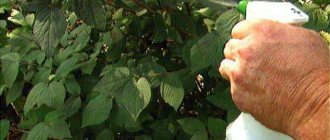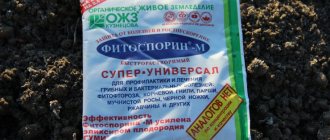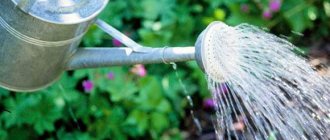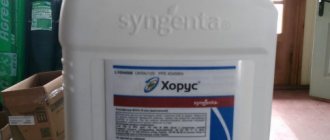The most common and intractable plant problem is late blight. This is a fungal disease caused by the simplest microorganisms - the fungi Phytophthora infestans. The fungus can infect the entire crop, thereby ruining the gardener’s efforts. How can you treat seedlings with Metronidazole? Most often, fungi affect tomatoes; cucumbers, beans, cabbage and other crops also suffer from fungi. Fungal infection is characterized by the appearance of dark brown spots and stripes on seedling cuttings, gray and brown spots on fruits and leaves.
As gardeners note, the onset of the disease often goes unnoticed, so it is easy to miss. Therefore, the most effective way to prevent the disease is to carry out preventive measures. Domestic lovers of growing their own tomatoes and cucumbers widely use a medical drug such as Metronidazole to combat late blight.
Treatment of cabbage vascular bacteriosis
A sign of vascular bacteriosis in cabbage is blackening of the veins and yellowness of the leaves, starting from the edge and reaching the middle of the leaf. A transverse section reveals blackened vessels.
To treat this bacterial disease, plants are sprayed with metronidazole once every ten days. The solution is prepared in several stages:
- crush 20 tablets of the drug;
- dissolve in a glass of warm water;
- dilute everything in 10 liters of water;
- let stand for 20 minutes.
Metronidazole is the best remedy for prevention
Metronidazole can be used not only for treatment, but also for the prevention of diseases. For tomatoes, cucumbers and cabbage, I place a whole tablet at the bottom of the hole before planting the seedlings in the ground.
Metronidazole solution protects tomatoes from fusarium blight
Also, I carry out preventive spraying in the second half of summer, when the amount of precipitation increases and the temperature remains between 25-30 degrees Celsius. These conditions are a favorable environment for the development of many bacterial diseases.
Metronidazole can be used as a remedy for yellowing of onions, you will find information about this in the article.
Treatment of bacterial spot of beans
The disease first affects bean leaves; watery spots appear on them, which grow into vague, brown spots with a characteristic yellow-green border. The stems are covered with red-brown stripes and break easily. Gradually, the beans also acquire a brownish tint with colorless plaques.
Treatment is carried out over the entire above-ground part of the diseased plant in dry weather. For spraying, a composition is made with 15-20 tablets of medicine dissolved.
Treatment of bacteriosis of cucumbers
Almost all varieties are susceptible to angular spotting of cucumbers, regardless of the growing method. The virus initially infects the leaves, causing yellow, uneven spots to appear on them, which eventually turn brown. When there is strong humidity, mucus forms. This infection is dangerous due to its rapid spread.
Sanitation is possible in two ways.
- For quick results, spray the entire plant in the afternoon, in dry weather. Use a solution with the following ratio: 1 liter of water / 1 metronidazole tablet / 1 milliliter of brilliant green.
- The soil can be disinfected. In this case, a less concentrated composition is used: 0.5 tablets are dissolved per 1 liter. Spill the garden bed with clean water, then water the bushes.
Zelenka (diamond green)
The famous brilliant green solution can be used instead of garden varnish to disinfect wounds and speed up their healing. To do this, take a cotton swab or swab, dip it in brilliant green and lubricate the cuts on trees and shrubs. In the same way, brilliant green can be used to treat rotten areas of dahlia tubers and gladioli bulbs during storage, as well as small cracks in pumpkins.
A solution of brilliant green can also be used for better fruit set in cherries. Dissolve 2 tsp. of this medicine in 5 liters of water and spray the trees immediately after flowering.
Experienced gardeners recommend treating defects and cracks on bulbs and tubers that are to be stored with an undiluted solution. Green paint can be used to treat small sections of plants when pruning.
Zelenka has proven itself well in the treatment of downy mildew (peronosporosis), which affects cucumbers, zucchini, pumpkin and onions. For treatment, 5 ml of 1% brilliant green per 10 liters of water for spraying once every 7-10 days (repeat three times).
Against powdery mildew, brilliant green is effective only in the early stages of the disease.
Treatment of bacterial cancer of tomatoes
This type of disease occurs in greenhouse and greenhouse tomatoes. There are two types. Diffuse cancer affects the stem and leaves, they wither, plants and fruits become covered with ulcers and spots. Local cancer is dangerous for the fetus. When you cut a tomato, yellow veins are visible that stretch to the seed chambers.
During treatment, diseased tomatoes are sprayed twice a day, morning and evening. The procedure is carried out every ten days. After the rain, the plants are again treated generously. To prepare the solution, take from 10 to 20 tablets of the drug.
Tomato leaf mold
The scientific name of the disease is cladosporiosis. The disease does not harm the fruits, but severely affects the leaves, which is why the number of ripened tomatoes may also decrease.
The disease can be identified by the condition of the leaves, which are covered with yellow spots on one side and a gray coating on the other. Cladosporiosis leads to the fact that the leaves dry out and new ovaries do not form.
To eliminate the manifestations of the disease, you need to spray the bushes with a solution of the drug (15 tablets and one bottle of pharmaceutical brilliant green are mixed in 10 liters of water). The solution should sit for some time. Treatments are carried out in the morning and evening.
The same remedy (but without brilliant green) can be used to prevent the onset of the disease in the first days of the growing season.
Treatment of root cancer of fruit trees
Apple and pear trees are most susceptible to this disease, however, it also occurs in other fruit and berry crops. Under the influence of bacteria, growths form on the roots and root collar. Tumors become woody, and the water supply to trees decreases. Rotting cancerous growths contaminate the soil.
Treatment is carried out by watering the root part of the plants, while disinfecting the soil. Settled water is used, metronidazole is dissolved in it at the rate of 0.5 tablets per 1 liter of water.
Using onion fly repellent
The onion fly is similar to a regular one, but smaller in size, not exceeding 7 mm. This small insect lays eggs near the onion plants. Damage to the harvest of both the first and second years is caused by the larvae that hatch from them. In first-year plants, pests suck out the juice of fresh leaves; in second-year plantings, they eat away the juicy bulbs.
Concentration of the composition for irrigation: 5 tablets per bucket of water. Processing should be done after weeding the onions. For prevention - immediately after planting.
Application of products in the process of growing onions
Many people know that carrots are an excellent neighbor to onion crops. Since you need to water the vegetable frequently with preventive agents, you need to make sure that they get as little as possible on the carrots, because it itself repels insects.
If you decide to water the onions with metronidazole as a preventative measure, it is advisable to water it immediately after planting the plant in the ground or after weeding it. This processing method will be more effective and will give the desired result.
In addition to the fact that the garden crop should be treated with substances that help fight diseases, we must not forget to water it with all kinds of organic fertilizers. These can be either ready-made complexes sold in stores, or ordinary ash, chicken droppings and other fertilizers. If you are too lazy to take preventive or therapeutic measures to eliminate diseases, then any onion pest can destroy the vegetable, among which the onion fly occupies a special place. Watering a crop with a substance such as metronidazole does not require much time, but the result will exceed all expectations.
Treatment of potato late blight
Late blight usually affects nightshades starting in mid-summer. The disease is easy to detect. Spots appear on the leaves, which quickly grow, acquiring a dark shade. White spores can be found on the bottom of the tops.
The best effect from the use of metronidazole in the fight against late blight can be obtained by starting spraying at the first symptoms of the disease. The ratio used for the composition is: 1 liter of water / 2 tablets of the drug / 1 milliliter of brilliant green. The bushes are treated very generously, disinfecting all parts of the plant. The procedure is repeated daily until all signs of the disease disappear. As a preventive measure, it is recommended to spray the drug at the beginning of the season and before harvesting.
How to treat yellow spots on cucumbers with Trichopolum
The appearance of yellow spots on the leaf blades of cucumbers indicates that the bushes are infected with fungal diseases. To effectively combat them, experienced gardeners use Trichopolum in the garden. In order not to harm the plant and fruits, the drug must be diluted with water. To enhance the effect, you can add other components that have antifungal or bactericidal properties.
Recipe for preparing the solution
To prepare a solution of Trichopolum for cucumbers and tomatoes in the garden, you will need the following components:
- Trichopolum tablets – 10 pcs.;
- brilliant green – 1 bottle;
- water – 10 l.
- Crush the tablets in a saucer or spoon. Dilute with a little water. Mix until the medication is completely dissolved.
- Fill the bucket with warm water. Add the diluted tablets to the liquid and pour in the brilliant green. Mix everything thoroughly.
Treatment of cucumbers with brilliant green and Trichopolum
Metronidazole solution should be sprayed on each cucumber bush so that the liquid covers it completely. Treatment with Trichopolum is required once a week, several times a season. For the medicine to work, care must be taken to maintain suitable conditions in the greenhouse. The optimal temperature is considered to be 25 degrees. If cucumbers are grown in open ground, after treating with Trichopolum, cover the bed, creating greenhouse conditions.
If you want to use Trichopolum for cucumbers and tomatoes as a prevention of possible diseases, the concentration of the substance should be halved. It will be useful to dilute whey in the medicinal liquid, which must first be heated to 25 degrees. It is allowed to resort to watering in order to prevent damage to cucumbers by fungal or bacterial diseases. The solution for this is made at the rate of 1 g of medicine per 10 liters of water.
Why use Trichopolum for plants
Trichopolum for cucumbers and tomatoes can be used for fungal and bacterial diseases of these plants:
- Late blight, which is one of the most common and destructive diseases for crops. Late blight manifests itself in tomatoes by the formation of gray or brown spots. Lesions may have different shapes. It is caused by fungi that spread through zoospores. The disease affects aboveground and underground parts of garden crops.
- Powdery mildew. This fungal disease spreads quickly. It can be transmitted through irrigation water, household tools used during planting, and air. Dew causes wilting, yellowing, and falling leaves. White coating impedes photosynthesis, which negatively affects the bushes.
- Fusarium is a disease caused by fungi. Penetrates into cucumbers through the soil and root system. The disease manifests itself through the formation of rot, thinning of the stems, and yellowing of the leaves. The rapid spread of microorganisms causes the death of the culture.
- Angular spot is a disease caused by bacteria. The disease affects almost all parts of cucumbers. It is expressed in the appearance of necrotic spots on the leaves that form along the edges. The disease leads to drying and death of the crop leaf. Such symptoms can then lead to the death of the cucumber and its unsuitability for fruiting.
Application of the drug to combat blackleg in seedlings
A sign that the black leg has affected the seedlings is darkening, and subsequently rotting, of the root collar. This usually happens before two or three leaves appear.
For processing, it is recommended to add a little warm boiled water to 1 tablet of the drug and mix until a paste forms. Then dilute with 1 liter of water and stir well so that there is no sediment. The seedlings are watered with a medicinal solution daily, sprayed once a week.
Metronidazole successfully fights bacterial diseases of various plant species, as well as pests. But you can protect vegetable and fruit crops by carrying out prevention with this effective remedy. Before planting, it is enough to add 1 tablet of the product to the hole, and then spray.
Beneficial properties of metronidazole for plants
The benefit of metronidazole for plants lies in the high content of the active substance - trichopolum. You can buy it in its pure form, but I couldn’t find it.
Trichopolum is the main active ingredient of metronidazole and can be used for the same purposes
This component has antimicrobial and antibacterial properties. With its help you can protect many garden crops from diseases. The use of metronidazole is recommended to exclude:
- vascular bacteriosis of cabbage;
- bacterial spot of beans;
- bacteriosis of cucumbers;
- bacterial canker and black spot of tomatoes;
- root cancer of fruit trees;
- bacterial cancer of grape bushes.
In addition to its protective properties, this drug is good at repelling insects, such as onion flies. I use the drug as an effective remedy in the fight against late blight and cladosporiosis (leaf mold).
Metronidazole is able to penetrate anaerobic and protozoan organisms, introducing a nitro group into their respiratory chain, resulting in a disruption in the respiration of microorganisms, and subsequently to their death. DNA production is also inhibited, which leads to the degeneration of bacteria.











